|
FAQs on: Betta Diseases: Infectious (Bacterial, Fungal...); Bloating,
Dropsy, Pop-Eye, Fin Rot... 3
Series FAQs: Infectious 1,
Infectious 3,
Infectious 4,
Related Articles: Betta Diseases,
Betta Systems,
Anabantoids/Gouramis &
Relatives,
Betta splendens/Siamese Fighting
Fish, Improved (Better?) Products for
Bettas!,
Related FAQs: Betta Disease 1,
Betta Disease 2, Betta Disease 3,
Betta Disease 4,
Betta Disease 5,
Betta Disease 6,
Betta Disease 7,
Betta Disease 8,
Betta Disease 9,
Betta Disease 10,
Betta Disease 11,
Betta Disease 12,
Betta Disease 13,
Betta Disease 14,
Betta Disease 15,
Betta Disease 16,
Betta Disease 17,
Betta Disease 18,
Betta Disease 19,
Betta Disease 20,
Betta Disease 21
Betta Health 22,
Betta Health 23,
Betta Health 24,
Betta Health 28,
Betta Health 29,
Betta Health 30,
Betta Health 31,
Betta Disease Causes/Etiologies:
Determining/Diagnosing,
Environmental (By far the largest cat.),
Nutritional,
Viral/Cancer,
Infectious (Bacterial, Fungal) ,
Parasitic:
Ich/White Spot,
Velvet;
Senescence/Old Age,
Cures/Curatives/Treatments,
FAQs on Betta Medicines:
Betta Medicines period,
Antibiotics/Antibacterials,
Anti-Protozoals (Metronidazole, eSHa...),
Copper,
Formalin,
Malachite Green,
Anthelminthics,
Organophosphates,
Salts,
All Other Betta Med.s,
|
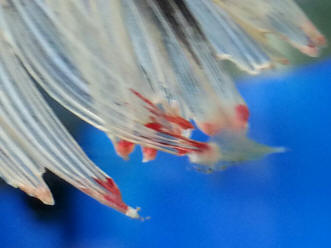 |
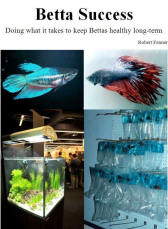 |
New
Print and
eBook on Amazon
Betta Success
Doing what it takes to keep Bettas healthy long-term
by Robert (Bob) Fenner
|
|
Betta with large wound and fin rot
8/19/16
Please could you help me.
My Betta looks awful. I am really afraid.
I have had him for 5 months, and it seems like he has had Finrot that
long.
<Mmm>
He developed this lump on his right side. Under the lump it looks like
an open wound. Now there is a big hole in his fin under that.
<I see this in your next -sent pix>
He is in a 10 gallon tank.
It has a filter and a heater.
The heater registers 76-78 degrees on glass thermometer and 82-84
degrees on the tape.
Daily AP Master Test Kit done daily -Normal
Ammonia 0, Nitrites 0, Nitrates 0,
<Zero NO3? Lo dudo. I'd have your water tested w/ another kit>
PH high- 7.8-7.4
Water conditioner- Prime
I do 25% water changes daily with partial gravel clean.
<I'd do these changes just weekly. Daily is too much... change,
disruption>
Eats well - Hikari Betta Bio-Gold 4-5 tiny pellets 2x day
Snack -Betta Dial-A-Treat 1-2 pieces of Mysis or Daphnia, or Blood Worms
every other day
Swims-well
Very personable
Breathing-good Gills good- I think
No PopEye, No swim bladder, no pineconing
I have tried Aquarium salt, Indian almond leaf, Metafix, <Melafix> and
KanaPlex. These are what I am using currently, all except the Metafix. I
am so afraid of hurting his liver or kidneys with all this stuff.
<You are wise here>
He has a few live and silk plants, cave and Betta hammock leaves.
Please if you have any other suggestions, I would greatly appreciate it.
I don't know if this is a parasite because it seems the antibiotic
doesn't work, and he is looking sicker. All the Pet store staff act like
"well he is only a fish." But he is a living.
Thank you so very much.
Christine.
<Your description covers most all the probable issues that folks have w/
environmental, nutritional causes of Betta trouble. Am inclined to
(unfortunately) suggest that this particular specimen may have a weak
genetic constitution. Betta splendens, like many other popular
freshwater tropical fishes, aren't "what they used to be" from so much
inbreeding. I'd try adding some good quality carbon to your filter;
adding a bit more/changing some out every month or so. There may be
"some chemical" issue here... that isn't mal-affecting the plants... and
am hoping the carbon may remove it. I do hope this helps. Bob Fenner>
|
 |
|
Betta with lump, hole, and fin rot
8/19/16
I just sent you an email asking if you could please help me. I forgot to
include a picture.
Thank you so very much,
Christine,
<I'd like to add two further suggestions: I WOULD dose this fish's water w/
an iodide-ate supplement
like this one:
http://www.seachem.com/reef-iodide.php
in case this is a I2 deficiency issue... and lace foods (soak them ahead of
offering) in a HUFA, vitamin supplement like this one:
http://www.seachem.com/vitality.php
Cheers, Bob Fenner>
Re: Betta with lump, hole, and fin rot; invoking deities
8/20/16
Dear Bob,
Thank you so very much for answering me so quickly.
I truly appreciate you and your advice.
I will do what you say.
Thank you.. And may the Lord God Almighty bless you, grant you and your loved
one's needs, and give you peace of mind and heart. I ask this in Jesus Christ's
Name. Amen.
Have a great weekend.
Yours truly
Christine
<Will accept kindly your good wishes. Not a fan of invisible friends however.
Cheers, BobF>
|
Betta recovery from flesh-eating nastiness.
8/16/16
Hello people very smart in all things fishy.
<Hey Dane>
I have a vexing (to me) issue with an admittedly elderly Betta. I
inherited him from a neighbor, who had kept him for 6+ months in a 2
quart bowl. I don’t think water was changed very regularly, and by the
time we got him one of his pelvic fins was completely gone, he had a
bunch of pin holes in his remaining fins, and his caudal fin was looking
a bit blackened at the edges.
<Ughh!>
We initiated lots of water changes, bought him a 6-gallon Fluval Edge
(which we planted and cycled) and eventually put him in the new home.
His fins healed (although the pelvic fin never re-grew and he has some
permanent bubbles in his caudal), his colors deepened, and he has seemed
to be thriving for over a year now. And I know, this puts him at
probably at least 2 years of age, and that’s after a pretty rocky first
year of life…
Until recently, his tank mates have included 3 small (3/4 inch) pygmy
Corys and a handful of red cherry shrimp as clean-up crew (I don’t know
exactly how many CRS, as they do seem to breed like bunnies). Again, the
tank is planted and water parameters have been pretty solid for over 11
months— ammonia at 0, nitrites at 0, and nitrates between 10 and 20 (I
can’t for the life of me distinguish between the API test kit’s shades
of orange for 10 vs. 20).
<Me neither>
Water changes of about 10-20% each week, with a missed week very
occasionally here and there. pH is a reasonably steady 7.4-7.6.
<Good>
This little fish had been doing great until about 2 months ago, when he
ripped his dorsal fin on a bit of the driftwood in the tank that had
gotten a little pointy somehow (I have since removed that pointy
driftwood). The rip was pretty dramatic, but I figured with good water
quality he’d just heal over time. This assumption was wrong. Within a
few days, the front half of his dorsal fin just died and fell off, and
then he developed a darkening of the tissue at the base of that fin (all
other fins looked and continue to look beautiful and healthy). Then, he
appeared to be developing some kind of body rot in a saddle-shape I
associate with columnaris, but without the white stuff, without the
mouth “fungus,” and without any kind of open lesions.
I moved him to a heated (80 degrees F), filtered 2 1/2 gallon hospital
tank and treated him just with some aquarium salt while I waited for
antibiotics to be delivered. Within 3 days, his back looked like it was
being eaten away– scales disappeared, he lost the rest of his dorsal
fin, and he developed grayish tissue on his back that looked necrotic.
Like something evil and yucky was just eating away at his flesh. But, he
was still alive, so I started thinking “maybe not columnaris?”
<Some sort of aggressive fungus or bacteria>
Anyway, I did a course of Kanamycin (Kanaplex) according to directions
(3 doses over 6 days). His appetite and energy improved but I didn’t
observe any healing; in fact, the eating-away-of-tissue seemed to
progress, albeit more slowly. So, I got some Furan 2 and after several
days initiated a combo treatment of Furan 2 with Kanaplex; I kept that
combo going for twelve days (12 days! Twelve is a lot of days!) without
seeing any obvious improvement in terms of regrowth. But the
tissue-eating did seem to stop, so there’s that.
We are now almost 8 weeks out from the initial injury. He now looks like
a really handsome shiny Betta out of whom a tiny shark has taken a bite
from the dorsal area. There is no redness or bleeding, just this pale
grayish/whitish furry-looking fuzz in the indentation on his back. This
fuzz does not look like the long-haired cottony fuzz of a fungus; more
like a swath of pale dirty fibrous velour. I don’t see any exposed
bones. His fins are not clamped. He is reasonably energetic (for an old
fish), and he swims about, lies on leaves, flaps his pectorals when a
human approaches the tank, flares at a mirror, and eats like a pig. Oh,
I’m feeding him New Life Spectrum Betta pellets, in case that’s
relevant.
<Tis; and a good choice>
Water parameters are still great (0 ammonia, 0 nitrite, <10 nitrate, pH
about 7.6, but steady at that level).
So, any ideas what the hell this was/is?
<As stated... would have to sample, culture, examine microscopically to
guess better>
And is there any chance he can rebuild the missing tissue?
<IF not eaten back to far (like the Pelvics; yes>
If so, how can I encourage that?
<Good care... water quality, nutrition. Time going by>
Over the past few (2-3) weeks, I’ve observed no re-growth of tissue,
skin, or scales— he appears to not be losing any more, but not
regenerating anything. 2-3 weeks seems like a lot of time to refrain
from healing. Any thoughts/recommendations?
<Perhaps lacing/soaking foods in a vitamin, HUFA supplement>
He doesn’t seem stressed or uncomfortable, but the appearance of his
back is rather dire. Is the velour-looking stuff a resurgence of
whatever has been eating him alive?
<Can't say>
Or does healing tissue take on such an appearance?
<At times; yes>
I don’t want to euthanize if he’s not suffering or beyond repair, but I
also don’t want to assume he’s not facing a potentially miserable end.
Thanks in advance for any wisdom, commiseration, or solutions you can
offer.
Dane.
<Thank you for sharing; your com/passion. Bob Fenner>
|
RE: Silver Dollar with single white spot on eye and hole in dorsal
Now; Betta damaged 8/14/16
Hi, Bob/Neale! Silver dollars all good now.
<Cool.>
However, my Betta male is now acting strangely: not eating and
alternating between sitting on his leaf (normal spot) and sitting on the
bottom of the tank. My parameters are the same as last I emailed you
(see below) and I did my regular 50% water change last Sunday. He has
bright red blood (?) on his lower fins.
<This is physical damage and incipient Finrot; identify the source of
the damage and medicate appropriately. So far as source of damage goes,
your checklist includes aggression from other fish, being sucked
into/onto a filter, pushed against jagged/abrasive ornaments, and
exposure to less than perfect water quality. On the medication front,
something tried-and-trusted (i.e., antibiotics and Antibacterials)
rather than tea-tree oils and similar.>
No one is picking on him....I have watched and watched and I even placed
a camera overnight to watch the silver dollars 2 nights. ...no
aggression.
Please see pics...any suggestions? He's pretty special...a rescue from
LFS.
Thanks in advance! KRISTI
<Hope this helps, Neale.>
|
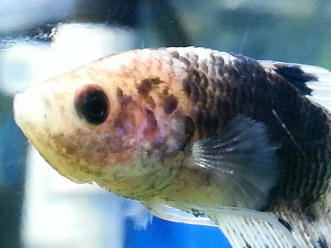
 |
|
Thanks, I'm treating with antibiotic and specific med for fin
8/14/16
rot.....started yesterday. Hoping he will recover. His scales are also
"raised".....
<If it looks like a pinecone from above, that's Dropsy. Do read on WWM re
the treatment of this using Epsom salt.>
didn't notice that until I moved him to an isolation bowl and could view
from the top. How long should I keep him isolated and treated?
<At least until the Finrot medication is done, assuming the hospital tank
is sufficiently big for this fish to enjoy good water conditions. Otherwise
medicate in the main tank -- no point isolating a fish in a breeding trap
(which stresses them) or in a tiny aquarium without a mature filter and
enough swimming space.>
Thanks so much!
<Cheers, Neale.>
|
Betta/fin fungus cure success
8/3/16
Hi crew, hope everyone is doing well. Wanted to share a success story thanks to
you... A month ago I saw my Betta was developing severe fin fungus on
his tail and anal fin, due to cloudy stagnant (and thus poor quality) water,
in my opinion. Unfortunately I noticed very late into the problem once his
behavior changed and these two fins were gone almost all the way to its body.
Thanks to a conversation we had a while back, I had some Kanaplex in "stock" and
decided to use it. I moved the Betta to a small bowl containing cycled
water from another tank--he immediately began acting normally, added an
ornament, and treated him with Kanaplex as per the package
instructions. I completely emptied the Betta tank and cleaned everything with
warm water, chucked the filter media, and let it air dry.
Meanwhile, I soaked new filter media in my other tank to cycle it. I filled the
Betta tank with Prime-treated water, replaced the cycled filter media, and put
the Betta back. As you have stated so many times, the Betta's fins slowly
started growing back. Two weeks later, he is 3/4 healed and doing great.
Between the Kanaplex suggestion, outside of the main tank, plus the clean water
and wait-and-see tips, your site saved this little Betta. Many thanks!
Matt
<Lovely to hear a story with a happy end for a change! Made by day. Thanks for
letting me know about this. Good luck with your fishkeeping! Neale.>
|
Betta eating tail fin?
7/20/16
Hi,
I have a Betta, Finn, in a 10 gallon heated, filtered, partially planted
tank, by himself. I have had Finn since Saturday. I think he is a Crowntail.
I noticed today that the top part of his tail fin looked shorter than when I
got him, but the rest of his fins look great, he explores his tank
constantly.
<The tail is damaged... from what? What other livestock is in this system?>
I haven't him eat yet, but he showed a little interest in Betta pellets I
put in the tank. Should I step up water changes to every week instead of
every two and that will take care of it, or is this possibly the beginning
of something and I should get medicine?
<I would treat as per Finrot. Please read here re:
http://www.wetwebmedia.com/fwsubwebindex/FWFinRot.htm
Thank you! Heather
Here he is:
<Well; Betta's will chase their own tails, and some can/do rot off if
physically damaged... but, this occurred so quickly... am thinking some
other organism is involved. Bob Fenner>
Betta eating tail fin? Neale's alternative
7/21/16
Hi,
I have a Betta, Finn, in a 10 gallon heated, filtered, partially planted tank,
by himself.
<Nice! Can I congratulate you on keeping this chap so well.>
I have had Finn since Saturday. I think he is a Crowntail. I noticed today that
the top part of his tail fin looked shorter than when I got him, but the rest of
his fins look great, he explores his tank constantly.
<Cool. Given space these fish are very interesting (and interested) animals.>
I haven't him eat yet, but he showed a little interest in Betta pellets I put in
the tank.
<If he's new to the tank, it may take a few days to settle in. Don't bother
feeding him if that's the case, and remove uneaten food. But if he's been in the
tank a couple days, then there may be an issue. Am I correct in suggesting the
tail fin has become raggedy? That can mean two things. First option, he's
getting trapped on an over-strong filter. As he pulls away from the filter inlet
his fins get torn. Turning the filter power right down can help. Air-powered
filters are best for Bettas and generally work fine without fuss. But if this is
a small internal canister filter or hang-on-the-back filter, then turning down
the suction will be required because these suck rather too hard for Bettas. If
you can't tweak the flow rate, it might be possible to jury-rig some sort of
plastic mesh an inch or so away the filter inlet to keep the Betta from getting
too close. Second option is Finrot, usually associated with water quality. If
ammonia or nitrite aren't zero, there's a high risk of Finrot. Finrot typically
results in white or pink patches on the raggedy fins as evidence of dead tissue
and inflamed blood vessels. Medicate as per Finrot using commercial medications,
but also do daily water changes (before adding that day's medicine) of around
25%. Don't feed while ammonia or nitrite aren't zero.
It takes about 6 weeks to cycle a brand new filter. In 10 gallons your Betta
should sail through the cycling process, but you will need to do regular water
changes. I'd suggest 25% water changes every day for the first couple weeks,
then every couple days thereafter.>
Should I step up water changes to every week instead of every two and that will
take care of it, or is this possibly the beginning of something and I should get
medicine?
<See above; if Finrot, medicate; if not Finrot, then frequent water
changes should fix things, and the fins will heal naturally.>
Thank you! Heather
<Welcome, Neale.>
|
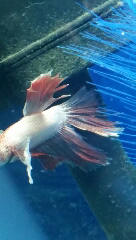
|
Re: Betta eating tail fin? 7/21/16
Hi Bob, thanks for responding so quickly. Finn is in the tank by himself
with some silk plants.
<Ahh: I see>
Is it possible he already had the Finrot when I bought him?
<Yes; this is the most likely...>
This is a still image of what he looked like when I brought him home:
<Very nice>
Thank you, Heather
<Welcome! BobF>
|
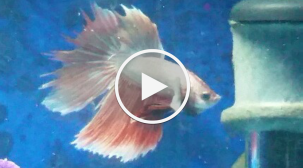 |
|
|
Betta Illness 2/27/16
Dear Crew,
I need your help as my Betta has white "stuff" on him and a grayish patch over
his nose that was never white. This pic shows the grayish patch over his nose
and the white "stuff" on his pectoral fin, which is also in other places on his
body but not many at all (weird). I am at a complete loss at how to treat Tiki
next.
<Could be extra mucous caused by irritation/stress, could be dead skin, could be
a bacterial infection. Hard to say from the photo. Luckily, treatment more or
less the same for each.>
Long story short, he got live plants for Christmas that ended up having 2 small
slugs that disappeared.
<Slugs?>
The plants did not flourish like his brother's Neptune and the death of an
Africa Dwarf frog, Athena, led me to Tiki's plight. I thought it was a fungus
but it probably is not.
<Fungus is usually very distinctive. Think cotton wool fibres.>
I went the natural treatment method in his 2.5 gallon tank of just water.
<This is, in my opinion, too small. I know about Bettas being kept in jars by
breeders, but that's not really practical for aquarists. How do you filter and
heat the water? If you don't have a filter then water quality won't be good
enough without daily 100% water changes (which is what breeders do) and without
a heater the Betta will become too cold and become sick (breeders keep their
jars in heated rooms maintained at 28 C/ 82 F rather than room temperature).>
I threw out the live plants, substrate and seashells.
<What sort of plants were you using? What sort of lighting did you provide?>
We are on Day 8 of 100% water changes daily with 2 tsp of aquarium salt and
almost 1 tsp of Epsom salt and 1.5 mL of API Stresscoat Plus.
<None of these will treat the above list of possibilities. To recap: salt is
cheap but treats only a very limited range of parasites; Epsom salt is also
cheap but basically works against bloating and constipation only; and Stresscoat
is used during transportation of fish to minimise some types of stress (hence
the name) but otherwise has no particular value to aquarists.>
He is active and eating like a pig, but he is also a very strong spirit too.
There is so much "controversial" research I have no idea what to do next as our
10 days are up soon.
<Here's the thing. The controversies exist mostly on forums and conflicts
between some web pages, basically arguments between people who've kept a couple
of Bettas and now think themselves experts. Pick up an aquarium fish health book
though and you'll see the basic ideas about how to maintain tropical fish are
very well understood. Have been for decades, with one or two outstanding areas
of uncertainty. Bettas crystallize these problems
beautifully. Pretty much every aquarium book written will tell you to keep them
like any tropical fish of similar size. But a few Betta people online insist
they can be kept in some magical way counter to the laws of physics!
Unheated tanks with little water, no filtration, minimal variety of food. I
don't know how this applies to your situation because you haven't said anything
about heating and filtering, but I'm putting all this food for thought out
there. While 2.5 gallons might work with a bit of effort, you will need
filtration and heating, and for plants, some type of overhead
lighting (though be warned, Bettas jump out of open-topped tanks, and
furthermore, without humid air trapped under the cover or hood, cold air can
cause health problems to these air-breathing fish adapted to humid, warm air.>
It maybe Ich but he wasn't scratching up against anything. He has been plighted
by this for 1 month before I caught it with Athena's ill-health.
Plus the grey patch on his nose makes me think it is not Ich but a bacterial
infection. Will you identify what is wrong with him? If you don't mind can you
clarify a myth from reality on aquarium salt. I know Bettas are freshwater fish
but since I have used it with Tikster I think it maybe a good idea to
incorporate it into every water change for Tiki and Neptune. How much aquarium
salt would you add to weekly water changes for Bettas in a 2.5 gallon tank? Or
would you not recommend doing that?
<See above; I'd be treating as per Finrot, using some trustworthy medication
(not Melafix, Bettafix, etc.) but more like the old Maracyn 1 + 2 combination,
or Maracyn Plus, or Kanaplex, or in the UK, I'd recommend eSHa 2000 as
economical and effective.>
Thank you for your time. I stumbled on your website in my research and ended up
reading the compassionate post on posting the right picture size.
So, for sure I thank you for any and all Betta care information you can give me
as I appreciate you do this because you are passionate about it. I believe you
when you say you are experts.
<Perhaps better to say: we have a lot (many decades) of experience of keeping
fish, and that includes having made LOTS of mistakes, which we try to help
others avoid.>
My next step is to bring Tikster to my Vet but it is winter here and I don't
want to put him through that stress.
<If he's eating, a trip to the vet is probably not necessary. He's still in good
shape. Medicate as per Finrot and he should recover, assuming the rest of his
environment is good (warm, zero ammonia and nitrite, pH and hardness
within the range needed for Betta splendens).>
Another solution is Bettafix that an uninformed PetSmart employee recommended
but anything from a company scares the shit out of me because I have a Betta and
do not want to harm him. There are not that many places
to turn to help my Tiki-baby or if Neptune-baby needs a professional.
<You're wise to be cautious. Some PetSmart employees are genuine fishkeepers and
have their own experience to draw upon. But most are minimum wage sales clerks
that will have received a trivial amount of animal health training beyond basic
shop floor display tank maintenance. If you've got $6 to spend, you could do a
lot worse than download Bob F's "Success with Bettas" book that summarises
everything you need to know about the species in a Kindle/eBook-friendly
format...
http://www.amazon.com/Betta-Success-Robert-Fenner-ebook/dp/B00HFAACII/ref=sr_1_5?s=digital-text&ie=UTF8&qid=1456572335&sr=1-5
Otherwise, there are all sorts of aquarium healthcare books on Amazon, and even
secondhand copies of things like "Interpet Manual of Fish Health" are well worth
the couple of bucks they'll set you back.>
Thanks again,
Maygan
<Hope this helps, Neale.>
|
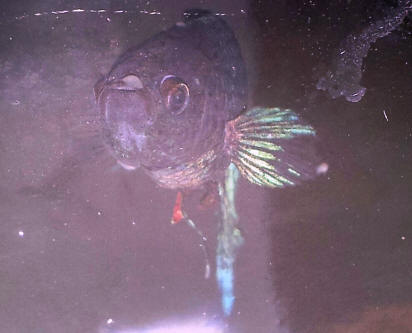 |
|
Betta Help Please 2/23/16
<Kris; in future, trim, re-size your image files to no more than Kbytes... we
have limited send space>
Hello Crew, Many thanks to Neale who has helped me out previously with my
freshwater community tank but alas, now I have yet another question about my
Betta!
To give you as much info as possible: we recently acquired a female (although I
am not 100% convinced she's not a "he")
<The one in the pix is definitely a male>
Betta, my kids have named her Sunset and she is very feisty. She lives in a 3
gallon filtered, heated tank with both live and fake (soft) plants and a sand
substrate, with some gravel from my cycled 20 gallon mixed in to help with the
beneficial bacteria.
<Good>
She has live floating plants that she enjoys resting in. I know that maintaining
a true cycle in a tank this small is next to
impossible
<Mmm; not so. Do you have another established system you can move cycled water
from to here? Does your source water have enough hardness to support
bio-filtration? Is the pH naturally too-low>
so I have been doing 20% water changes every other day ( 2 of them now in the
last 5 days) She eats well, currently about 4 Betta pellets per day (2 2x per
day) and as we have only had her about 5 days I have a plan to go pick up some
other food options for her this weekend to vary her diet.
My issue is her tail! When she came home, her long tail was almost ladle shaped,
like, it formed a cup at the bottom. The next day I noticed that the "cup" was
gone and the end of her tail had frayed.
<Yes; classical "fin fungus"; actually environmental stress...>
I did have a small kind of spiky fake plant in the tank and assumed she had
caught it on that plant. I hadn't even thought of her getting her tail caught in
that - I felt terrible and immediately removed the plastic plant, leaving her
with
2 silk plants and a bunch of floating live plants.
I don't know if her tail is just damaged from that and it is an injury or if we
are dealing with fin rot or the like.
<Both at this point; but you REALLY need to fix the environment: NO ammonia,
nitrite, less than 20 ppm nitrate, a pH about 7.0, some alkalinity... THEN the
use of an antibiotic may make sense. READ HERE:
http://www.wetwebmedia.com/fwsubwebindex/BetDisInfeF.htm >
I just can't tell! But the splits are growing longer, while her tail seems the
same length the frays are definitely worse. I have included pictures (with
sincere apologies if they aren't sized small enough - I tried!) for you to look
at - are you able to please give me some guidance here?
<As stated... the env. first and foremost>
I have always loved Bettas and want too do right by her, <him> but I don't want
to treat for something if it is just something that regular water changes can
help fix. Like I said she eats well, creeps around her plants, and is very
interactive. She seems happy, but with fish how can you tell.
I really appreciate all you do - I have learned so much reading (and reading,
and reading!) your site - you guys (and gals!) are fantastic.
Regards,
Kris
<Cheers, Bob Fenner>
|
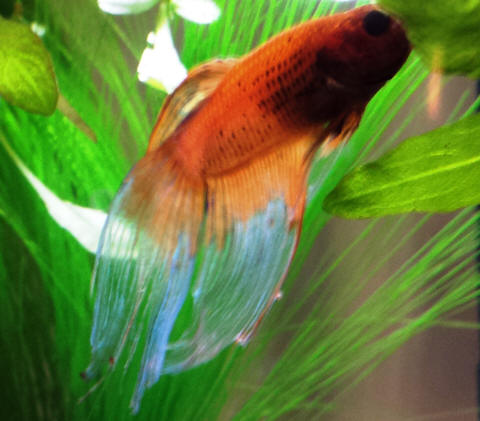
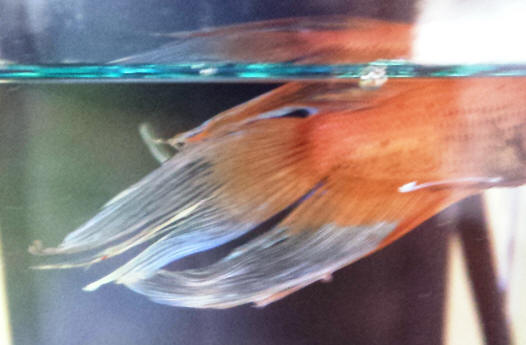 |
|
Re: Betta Help Please 2/23/16
Hi Bob wow thank you for the fast reply!
<Welcome. Did send to Neale as well; for his independent reply... he's in the
UK, a teacher... so thought it expedient to respond now>
I do apologize for the image size
<We have a limit... 50 megs... that when it gets full, "bounces" incoming
mail... And in other countries, file-size can be trouble; with the net being
SLOW... Hence our stated requirement in writing us>
- I am not very good at things like that. I had a feeling "she" was a "he"! Well
I won't tell my 7 year old daughter that, I suspect the Betta won't mind being
referred to as a female lol.
<Ah yes>
Our water here is a bit on the hard side, and yes I do have a cycled 20
gallon community tank I could use water from.
<GREAT! Do just use the "olde" water from the 20 in the Betta system period>
One thing - I have noticed that the heater is not consistent - I just checked
and even though it is set for higher the water was only at 73 degrees!
<Mmm; needs to be higher and steady. Do trade this in at the shop if it's new>
Argh, I will be ordering a new heater - In the meantime, I do have a large
breeding net, would it be beneficial at all to house him in the breeding net in
my large cycled tank (with the floating plants he loves)?
<YES!>
The water parameters (and temperature!) is stable in that tank. It will take a
week or so for the new heater to arrive. I purchased the only one I could find
small enough for a 3 gallon tank but it seems to fluctuate in temperature. I
would love
to ultimately add him to the community tank, but as I have 4 guppies (although
none with very long tails) I am not sure I should risk it, which is why I made
sure to have a separate tank for him from the get go.
<They might pick at each other; but worth trying>
( the other inhabitants are 6 black phantom tetras and 4 Corydoras). Your
thoughts on the net and at least having him in stable water to see if that can
stop the progression?
<As stated. I would move this Betta here>
And lastly, at what point do I opt for antibiotics?
<Much more tearing, lethargy>
And which ones would you recommend.
<... the reading where I've referred you. B>
Again I truly appreciate your advice! Thank you for all you do.
Re: Betta Help Please 2/24/16
Excellent I can't thank you enough. Will be moving him right now to the net
in the community tank and watching his behavior for any warning signs. As of now
his behavior hasn't changed so we will see if him being in the big tank will set
him straight. The heater is new yes so I'll try to return it to the store and
see if the new one when it comes in keeps a better temp. The temperature in the
community tank is a very stable 78 degrees. Again
my sincere thanks :)
<Certainly welcome. BobF>
Betta Help Please /Neale's addn. 2/24/16
Hello Crew, Many thanks to Neale who has helped me out previously with my
freshwater community tank but alas, now I have yet another question about
my Betta!
To give you as much info as possible: we recently acquired a female
(although I am not 100% convinced she's not a "he") Betta, my kids have
named her Sunset and she is very feisty. She lives in a 3 gallon filtered,
heated tank with both live and fake (soft) plants and a sand substrate,
with some gravel from my cycled 20 gallon mixed in to help with the
beneficial bacteria. She has live floating plants that she enjoys resting
in. I know that maintaining a true cycle in a tank this small is next to
impossible so I have been doing 20% water changes every other day ( 2 of
them now in the last 5 days) She eats well, currently about 4 Betta pellets
per day (2 2x per day) and as we have only had her about 5 days I have a
plan to go pick up some other food options for her this weekend to vary her
diet.
My issue is her tail! When she came home, her long tail was almost ladle
shaped, like, it formed a cup at the bottom. The next day I noticed that
the "cup" was gone and the end of her tail had frayed. I did have a small
kind of spiky fake plant in the tank and assumed she had caught it on that
plant. I hadn't even thought of her getting her tail caught in that - I
felt terrible and immediately removed the plastic plant, leaving her with 2
silk plants and a bunch of floating live plants.
I don't know if her tail is just damaged from that and it is an injury or
if we are dealing with fin rot or the like. I just can't tell! But the
splits are growing longer, while her tail seems the same length the frays
are definitely worse. I have included pictures (with sincere apologies if
they aren't sized small enough - I tried!) for you to look at - are you
able to please give me some guidance here? I have always loved Bettas and
want too do right by her, but I don't want to treat for something if it is
just something that regular water changes can help fix. Like I said she
eats well, creeps around her plants, and is very interactive. She seems
happy, but with fish how can you tell.
I really appreciate all you do - I have learned so much reading (and
reading, and reading!) your site - you guys (and gals!) are fantastic.
Regards,
Kris
<To add to Bob F's comments... the pink patches on the fins are where blood flow
has become congested. That's where bacteria are invading the fin tissue.
Eventually, the clogged up blood flow means oxygen and nutrients can't get to
nearby fin tissue cells, and those cells die, and that becomes the raggedy edge
of Finrot. So, when you see raggedy fins, pink patches in
the clear tissue, and quite possibly white patches of dead cells, you
immediately think Finrot and treat accordingly. One side to this is to identify
the cause, may be physical (for example fin-nipping by tankmates) while the
other way is environmental (too cold, non-zero nitrite/ammonia, that sort of
thing). Often physical damage that would heal naturally can't because the
environment is wrong. So look at things critically, and be sure to optimise
living conditions ALONGSIDE medicating as per Finrot. Do bear in mind that under
good conditions damaged fins heal without problems, much like cuts do on humans.
It's only when something isn't right about the environment that a simply tear in
the fin ends up becoming infected. Hope this helps, and thanks for the kind
words, Neale.>
Re: Betta Help Please 2/24/16
Thank you Neale.
<Welcome.>
Yes I wish I had caught on earlier that the heater wasn't working properly, so
my hypothesis is that his tail must have become damaged on that plastic plant I
have now removed and then the less than optimal temperature allowed the fin rot
to take hold. I feel quite terrible about it, but all I can do now is try to fix
this as best I can.
<Quite so.>
I have now placed him in the breeder net in my main tank where the water
conditions are stable and have turned the heather up slightly to 80 degrees to
assist with the healing. He seems quite content in there, aside from puffing up
his gills at the curious guppies a few times, he is now relaxed.
<Excellent.>
I have read on your site mixed reviews about using Epsom salts to promote
healing (I haven't added anything yet, going to wait to see if the better water
conditions allow him to heal on his own), but as I have Corys in the tank as
well I would be hesitant to do so anyway.
<Epsom salt will do no harm to Corydoras. All this stuff about "catfish being
allergic to salt" specifically refers to sodium chloride (salt-salt) rather than
magnesium sulphate (Epsom salt), and even in this case, sodium chloride is less
toxic to catfish than widely used copper- and formalin-based medications. In any
event, neither do much to treat Finrot.
Optimal water conditions will help, but a standard Finrot medication is what you
need. In the UK I recommend eSHa 2000 as being tolerated by a wide variety of
fish; in the US, better to use antibiotics where possible as less likely to
cause problems than copper- and formalin-based medications.>
Should it get to the point where I have to medicate him I will of course do so
in his 3 gallon (using water from my cycled big tank as per Bob) as not to risk
the balance in my 20 gallon. All in all I have my fingers crossed he is able to
recover, I will be watching him closely should his behavior change - so far he
is eating well and still quite active so I am optimistic that it has been caught
in time.
Many thanks to you both, I am new to the hobby and have not lost a single fish -
a fact that I very much credit to your site and the information I have learned
there.
Regards, Kris
<Very heartening to hear! Cheers, Neale.>
Re: Betta Help Please
Thank you - one more thing, sorry! I am in Canada, all I can seem to find is
Erythromycin or Tetracycline - which of these antibiotics would be the correct
one to use?
<Both should do the trick, but I'd probably go for the Tetracycline.
Cheers, Neale.>
Re: Betta Help Please 2/24/16
Thank you! If he isn't showing any signs of improvement in the next couple of
days I will put him back in the small tank to treat with the antibiotic.
I'm so grateful for the advice - I will let you know how it goes! :)
<Thank you Kristie. Bob Fenner>
Re: Betta Help Please 2/28/16
Hi Bob/Neale, I appreciate your time helping me out with my Betta fin rot
problem.
<Glad to help. >
So I have had my Betta in the breeder net in my main tank to see if the stable
temp (80) and stable water parameters would help his immune system kick the fin
rot.
It hasn't.
<Time for treatment then>
While it doesn't appear to have gotten worse (he hasn't lost more of his tail
since moving him in here, and he is
active and eating well - in fact he doesn't seem bothered at all) but I am
thinking I may be at the antibiotic point now as I am not seeing any
improvement. Your thoughts?
<I would treat... w/ Kanamycin or Nitrofurazone if you can get it... eSHa 2000
if you can't>
My concern is this: I have a 3 gallon up and running (and will be picking up the
new heater today), however I know with antibiotic treatment you can't do any
water changes for a full 5 days - how on earth am I to keep the water/ammonia
etc levels safe for a whole 5 days in just a 3 gallon tank?
<The biological filtration should keep this at bay; otherwise, massive water
changes from your 20>
Am I correct to assume that treating him in the 20 gallon he is in now would be
disastrous for the established cycle of that tank?
<Possibly>
I so carefully cycled, added fish slowly etc and haven't lost a fish. I would
hate to upset the now established balance. What do you suggest as the best way
to handle this situation?
<Treat the Betta in the 3 gal.>
I really appreciate your time and advice - this is my first fish "crisis" and I
want to handle it in the best way possible.
Kind regards, Kris
<Have you read here?:
http://www.wetwebmedia.com/fwsubwebindex/BetDisInfeF.htm
and the linked series above? Bob Fenner>
Re: Betta Help Please 2/28/16
Thank you Bob :)
All I was able to get my hands on here was tetracycline which Neale had said
should do the trick.
<Better than zip>
I got the temp up in the 3 gallon, filled with water from my 20 gallon and have
put the Betta in there and begun
treatment. I'm hopeful since his behavior and eating hasn't changed that I am
treating in time and will be successful.
Again I'm so appreciative of your time here. I'll let you know how it works
out! If the treatment works how long does new growth take? Aesthetically we
don't care but it would be nice to know definitively that he's getting better.
All the best. K
<B>
Re: Betta Help Please 3/5/16
Hi Neale/Bob, I just wanted to give you an update - hope you don't mind!
I don't want to clog up your email :)
<Appreciated. Just no big files!>
The betta has completed his antibiotic treatment, and while it is too early to
notice any regrowth the red spots at the end of his fins have gone and it
appears that the treatment worked. His fins are still ragged, but no
discoloration or red bits so I think/hope that's a good sign.
<Yes>
He is active and eats well and is very interactive.
<This also>
In an effort to prevent any future water quality issues I did decide to try him
in the big community tank
(where the water is stable and fully cycled for a number of months now)
and watched him very closely. I have one section that is fairly heavily planted
(sword and anubias, java fern) which is on the opposite side of
the filter flow and he has claimed a little territory there (I am gradually
working on a fully live planted tank - currently it is a mix of live/flake). He
doesn't appear to be overtly aggressive to the other fish - he ignores the
tetras and cories - has even been caught laying side by side with the cories!
and only flares at the curious guppies when they come into "his" plants - once
he chases them off he goes back to swimming around his
area. He even built his first bubble nest within an hour of introducing him to
the big tank. I don't know if that is a sign of him being content but it was
interesting to me that he not once built a nest in his 3 gallon, but did
right away here. Either way I will be watching him carefully and will remove at
first signs of trouble. Thank you again for your help - I appreciated you both
taking the time to walk me through me first fish illness. :)
Take care, Kris
<And you; BobF>
|
|
|

